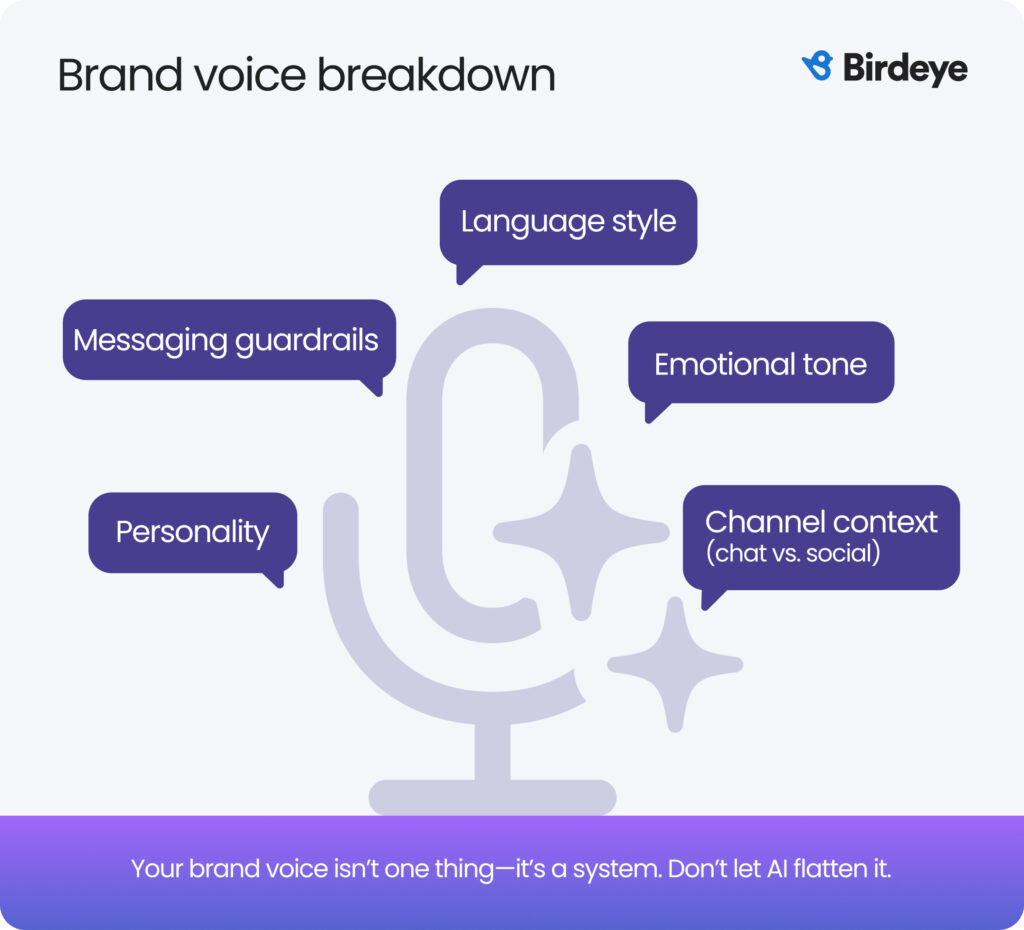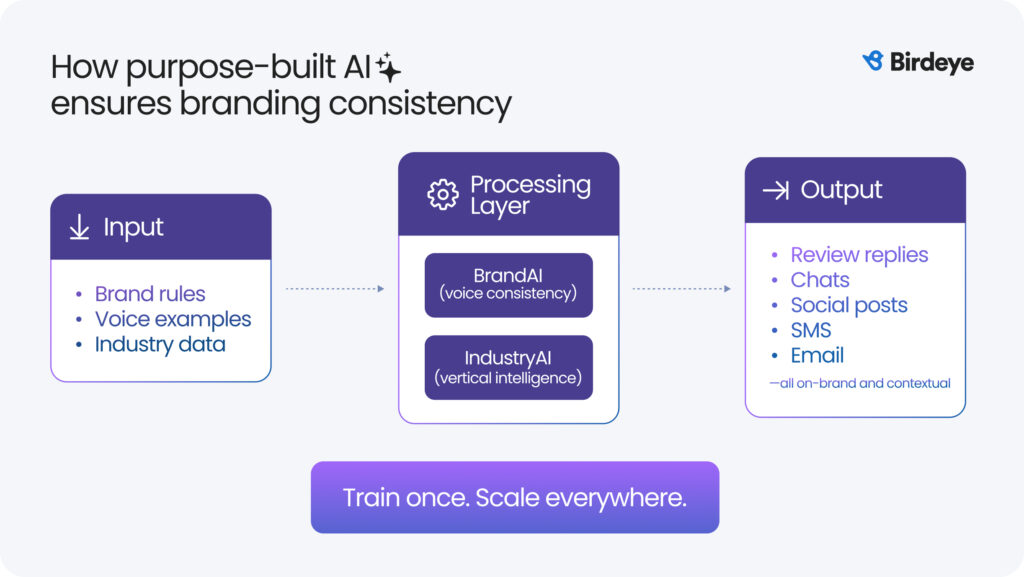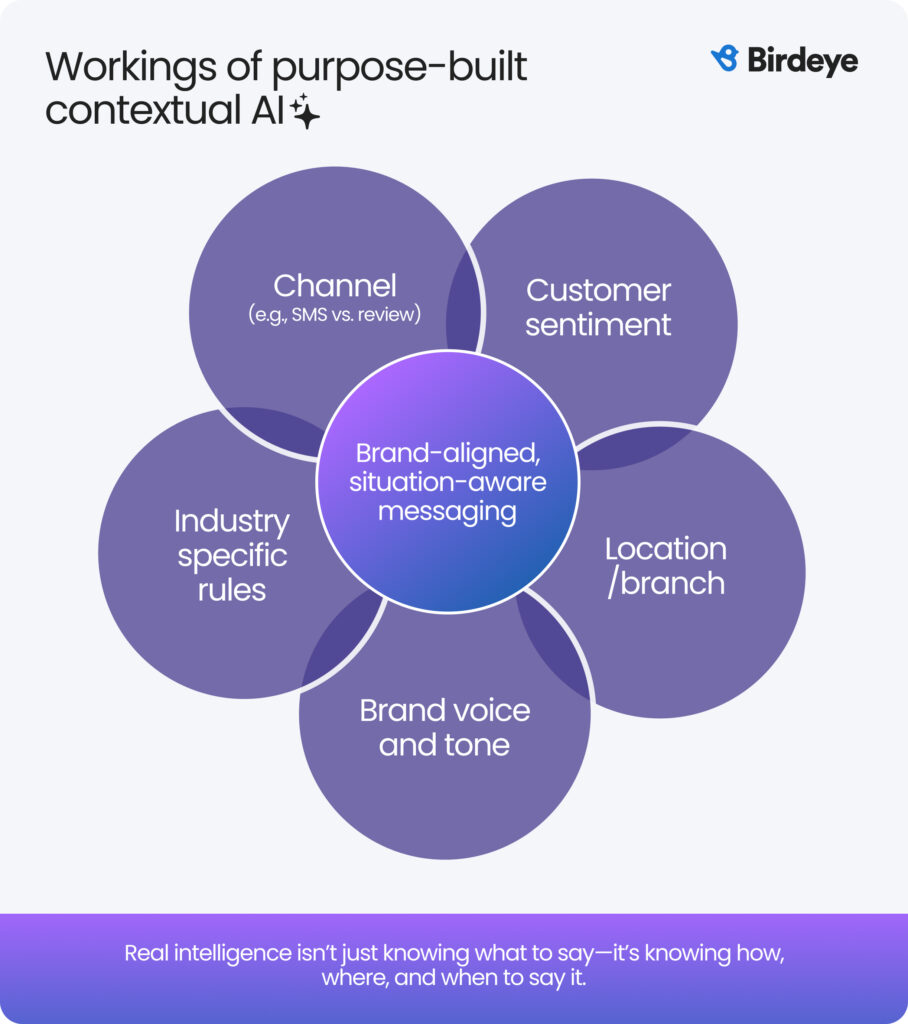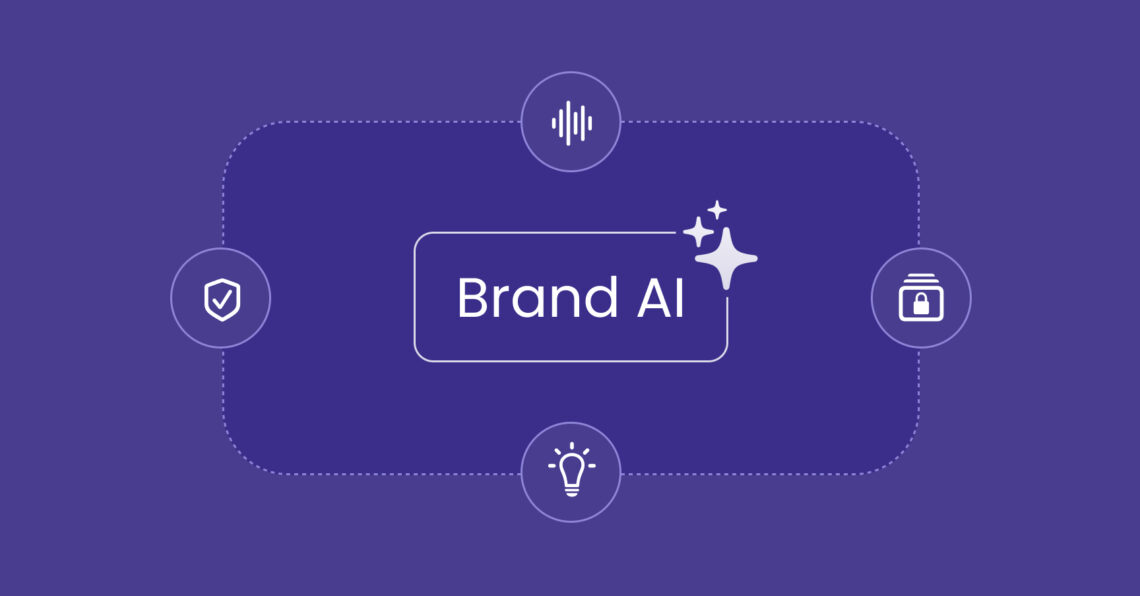In the race to scale faster, smarter, and cheaper, most multi-location businesses have turned to AI marketing tools—and with good reason. They can help scale content production, automate client responses, and simplify marketing management. Of course, relying on AI for brand voice compliance is easier said than done.
According to Salesforce research, 71% of marketers expect GenAI to eliminate repetitive tasks, allowing more time for strategy-based decisions.
This high adoption rate and expectations can be good news for multi-location businesses, looking to grow faster than their competitors. However, ensuring AI aligns with your brand voice remains a consistent challenge. AI is only effective when it’s trained to communicate in a way that reflects your unique brand voice and identity. After all, businesses don’t just want content – they want content that leads to sales and community.
That is why you need purpose-built AI solutions that understand your brand voice, industry nuances, and compliance requirements without being told every single time.
Learn how training AI to capture your brand voice can be a game-changer for your enterprise.
Table of contents
- What is brand voice, and why is it hard to define for GenAI training?
- General-purpose AI and the hyperlocal marketing problem
- How can purpose-built AI be used for a consistent brand voice across channels?
- How purpose-built AI functions as contextual AI solutions for brand conversations
- Bottom line: Switch to purpose-built AI to secure brand voice across channels
- FAQs on AI for brand voice
- BrandAI: The next step in making AI your trusted partner in business communications
What is brand voice, and why is it hard to define for GenAI training?
Brand voice is more than just the words you use. It’s how you say them—your personality, rhythm, tone, attitude. Whether they’re reading a social post, a review reply, or an email newsletter, your recognizable style helps customers know it’s you. Yet, most brands struggle to maintain that “consistency,” especially as they grow or evolve.
A consistent brand voice is a major concern for businesses working with general-purpose AI solutions like ChatGPT or Gemini. They must constantly tweak responses, rely on individual managers to infuse brand voice, and repeat prompts to the AI tool.
Why GenAI struggles to understand voice
Here’s the core problem: generic GenAI tools aren’t trained to understand your brand’s evolution, nuances, or strategic tone shifts.
Most AI content tools work by:
- Ingesting massive public datasets (not just your brand materials)
- Optimizing for average readability (not your distinctiveness)
- Producing grammatically correct but emotionally bland outputs
That’s why so many brands are now sounding suspiciously similar online—same sentence structure, same “safe” tone, same buzzwords. The result isn’t just sameness. It’s brand erosion.

The deeper challenge: Defining brand voice for AI training
Even when companies attempt to teach AI their tone, they run into roadblocks:
- Most brands haven’t formally defined voice beyond vague adjectives (“friendly and approachable tone but professional”)
- Style guides rarely cover multi-channel adaptation for AI-generated content (e.g., how your voice should shift for replies vs. captions)
- There’s no continuous feedback loop to refine outputs and learn from actual customer interactions
AI can’t intuit brand tone without structured, dynamic training data and guardrails—it can only guess.
That’s why brands need more than just AI that writes. They need AI that knows who it’s writing for.

Why brand voice keeps shifting
Your brand voice isn’t static. It naturally evolves over time with:
- Leadership changes: A new CMO may favor a bolder, more irreverent tone than their predecessor.
- Rebrands and repositioning: As brands target new demographics or markets, tone and style are often recalibrated.
- Channel expansion: Voice on TikTok isn’t the same as voice in a formal customer service email—and shouldn’t be.
This fluidity is necessary, but it makes voice notoriously hard to document, let alone scale.
One location might sound overly formal, another too casual, and a third might abandon your tone entirely. Left unchecked, this erodes customer trust and creates what we call “Zombie Branding”—a presence that looks alive but speaks with no real soul.
With varying target audience demographics, local context, and compliance standards, protecting brand voice across locations with GenAI can mean tedious prompting and enormous investment in human supervision.
As critical as brand voice adherence is, it is only half of the difficulties of managing branded communications with general-purpose AI tools. Hyperlocal relevance is the other crucial half.
Let us understand this closely before we explore how purpose-built AI bridges the gap.
General-purpose AI and the hyperlocal marketing problem
In hyperlocal marketing, relevance is everything. Your content must reflect local nuances while still aligning with the brand’s global identity.
For instance, a healthcare clinic in San Diego needs to speak differently than one in Brooklyn, but both must reflect a cohesive brand voice. Yet, many multi-location businesses are stuck trying to scale localized content with generic AI tools, often resulting in uniform, bland messaging that misses the mark.
The problem? Generic AI wasn’t trained on your brand or its nuances. It can’t fine-tune the tone to reflect a dental office’s friendly patient reminder rather than an urgent notification. For example, a dental practice in Austin might need a warm, reassuring tone, while a Chicago automotive shop requires direct, confident communication.

When AI tools treat both the same, brands lose their local flavor and authenticity. This widespread “zombie brand” effect leaves businesses sounding robotic and redundant, present everywhere but resonating nowhere. The bigger the business, the harder it is to maintain a unified brand voice across locations.
The issue isn’t AI itself—it’s using the wrong AI. To truly connect, brands need contextual intelligence: AI that understands their brand voice, unique tone, adapts to local markets, connects with the existing content and responds authentically at every customer touchpoint. That’s why businesses need purpose-built AI like Birdeye’s BrandAI – designed to scale local relevance without losing brand soul.
How can purpose-built AI be used for a consistent brand voice across channels?
General AI tools come in handy for producing content that you can afford to spend a lot of time on – blog posts, landing pages, web pages, etc. Even then, it would require a lot of brand voice prompting, revisions, and edits if you don’t know what you want right away.
However, businesses also need to create content at scale for social media, client conversations, review responses, and more. Generic GenAI solutions may not meet the requirements of such a complex content creation process for a large enterprise’s marketing strategy, business intelligence, and style.
With purpose-built AI solutions like Birdeye, businesses can ensure that their content aligns with the brand’s values, tone of voice, style, and content strategy. Businesses can also include custom instructions so that the content works across campaign, caption, comment, and conversation
Here’s how.
Deliver smarter campaigns without sacrificing tone for marketing
- Align marketing copy for various campaigns with your messaging pillars and CTAs.
- Customize voice by industry, channel, or location—no manual rewriting needed.
- Use built-in compliance guardrails to avoid tone drift or risky phrasing.
Hyperlocal social media marketing: Speak locally, stay on-brand
- Create post calendars tailored to each market’s events, offers, and cultural cues.
- Avoid the “copy-paste” syndrome of templated posts.
- Empower local teams to generate content within brand-approved boundaries.
Customer outreach: AI that doesn’t just respond—it represents
- Maintain a consistent tone across SMS, reviews, email, and chat
- Adapt messaging for empathy, urgency, or sales—without sounding robotic.
- Ensure AI doesn’t just respond fast—it responds faithfully.
Ensure branding consistency across all communications with Birdeye
Want to see the impact of Birdeye on your business? Watch the Free Demo Now.
How purpose-built AI functions as contextual AI solutions for brand conversations
Most AI can respond. Very few can understand.
That’s the difference contextual AI brings to customer interactions. It goes beyond keywords to interpret unique style and word choices and understand:
- Who the customer is
- What their intent might be
- Where they’re interacting (review, chat, social, etc.)
- How your brand is supposed to sound in that moment
It’s not just about answering quickly—it’s about answering correctly, in tone, context, and real time.

With Birdeye’s BrandAI and IndustryAI, you get:
- Hyper-personalized messaging that flexes by channel, tone, and customer sentiment
- Compliance baked into every response, so nothing goes off-brand
- A scalable system where AI doesn’t just assist—it represents your brand authentically
Bottom line: Switch to purpose-built AI to secure brand voice across channels
In a world where AI can write for everyone, the brands that win are the ones that still sound like themselves. Generic tools may save time, but they can’t protect what makes your business unique—your voice, tone, and identity.
Purpose-built AI changes that. It learns how you speak, adapts to your local markets, and ensures every touchpoint feels authentically you. Whether it’s a review reply, a campaign ad, or a chatbot message, BrandAI helps you scale without sounding soulless. It’s not just smarter AI—it’s your brand’s new best advocate.
FAQs on AI for brand voice
Machine learning has automated personalization and insights, but often at the cost of authenticity.
Train a purpose-built AI like Birdeye using your existing content, tone guidelines, and compliance rules.
Start with examples, approved phrases, and brand-safe language. Then, tune AI over time with real interactions.
It’s AI that tailors outputs based on context, such as customer mood, location, channel, and industry norms.
Yes, AI can adapt brand tone to local nuances with the right tools while maintaining central messaging.
BrandAI: The next step in making AI your trusted partner in business communications
When every brand sounds the same, customers stop listening. That’s the risk we opened this blog with—and it’s precisely what Birdeye’s BrandAI was built to solve.
BrandAI doesn’t just generate content. It embeds your voice, tone, and messaging rules into every interaction—whether it’s a review response, a chatbot conversation, or a local Instagram post. Paired with IndustryAI, it becomes even more powerful, tapping into vertical-specific intelligence grounded in real-world data across thousands of businesses.
Together, they help your business:
- Define and protect your brand voice with AI trained on your tone, rules, and preferences.
- Generate on-brand responses at scale—across reviews, messages, chats, social, and email.
- Adapt messaging per location with hyperlocal context and customer sentiment in mind.
- Maintain compliance and consistency across regulated industries and multi-location teams.
- Reduce team effort and errors by automating content without compromising control.
With BrandAI + IndustryAI, AI finally becomes a trusted brand guardian, not a brand risk.
Ready to make AI work for your business—and not vice versa? Watch our video now to take the next step.
Originally published









